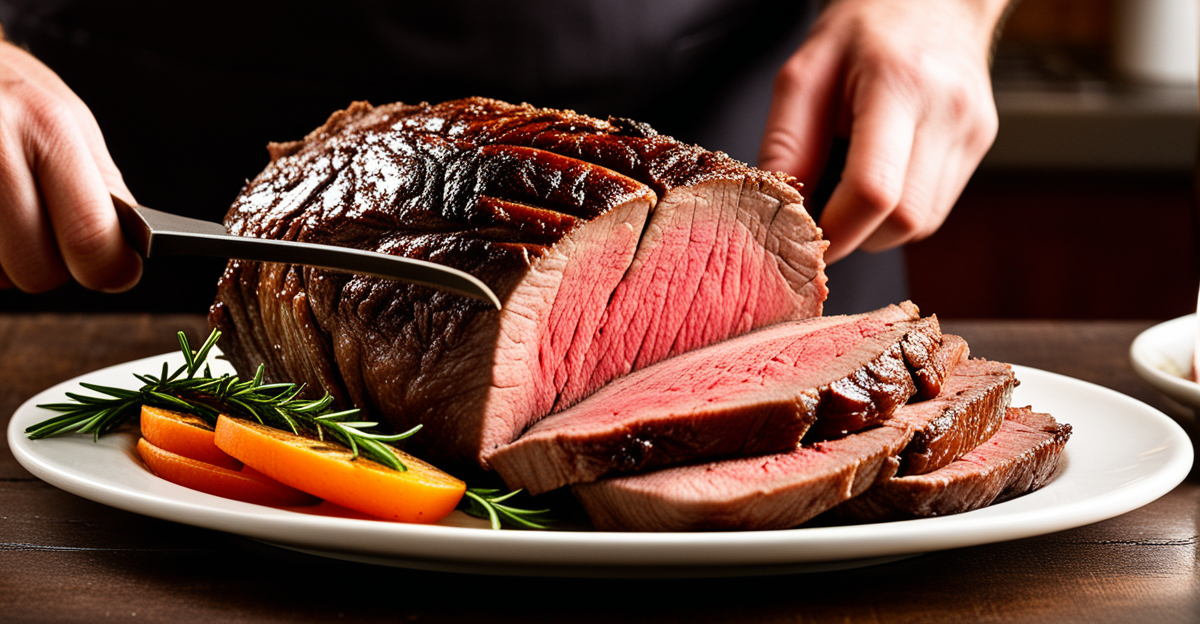Essential Cuts and Preparation Techniques for Roast Beef
Selecting the best beef cuts is crucial for achieving a traditional roast beef that is tender and flavourful. Popular choices include the rib, sirloin, and topside cuts. The rib offers rich marbling, enhancing juiciness, while sirloin provides a leaner but still tender option. Topside is economical and benefits from careful preparation to avoid toughness.
Before cooking, proper trimming and tying techniques ensure even roasting. Trim excess fat for balanced flavour without overdoing it—some fat helps retain moisture. Tying the roast with kitchen twine keeps it compact, promoting uniform cooking and an attractive shape.
Have you seen this : How can you infuse modern flavors into classic British pies?
Marinating and seasoning add authentic flavour profiles. Classic preparation involves seasoning with salt, pepper, and herbs like rosemary or thyme. Marinating the beef with garlic, wine, or mustard can tenderise the meat while deepening flavour. For best results, marinate for several hours or overnight in the refrigerator.
By focusing on these preparation tips and selecting the right beef cut, you set the foundation for a perfect traditional roast beef that is both tender and delicious.
This might interest you : How can you prepare a classic trifle with a modern twist?
Step-by-Step Guide to Roasting Beef
Achieving the perfect traditional roast beef begins with proper oven preparation. First, preheat the oven to a temperature between 180°C (350°F) and 200°C (390°F), depending on the beef cut. For fattier cuts like the rib, a slightly lower temperature around 180°C ensures gradual cooking, preserving juiciness. Leaner cuts such as topside can handle the higher end, helping develop a crispy exterior.
Cooking times vary greatly by cut and weight. A general guide is 20 minutes per 450g (1 lb) for medium-rare doneness. Use a meat thermometer to check internal temperature precisely. Medium-rare roast beef should be around 55-60°C (130-140°F) inside, whereas medium approaches 65°C (150°F). Visual cues like a browned crust and slight firmness help confirm readiness.
Resting the roast beef is crucial for retaining juices. After removing the meat from the oven, cover it loosely with foil and let it rest for at least 15 minutes. Resting allows the meat fibers to reabsorb moisture, resulting in a tender, succulent roast.
By following these roast beef cooking times and oven temperature guidelines along with resting, one can confidently prepare a classic roast using traditional roasting methods with optimal flavour and texture.
Step-by-Step Guide to Roasting Beef
Achieving the perfect traditional roast beef begins with controlling roast beef cooking times and oven temperature for roast beef precisely. Preheat your oven to 180°C (350°F) for most cuts, including rib and sirloin. This temperature balances thorough cooking while preserving juiciness and tenderness.
Cooking times depend largely on the cut and desired doneness. For example, a 1.5 kg rib roast generally requires about 20 minutes per 450g for medium-rare. Using a meat thermometer is critical: aim for 52–54°C (125–130°F) internal temperature for medium-rare and 60–63°C (140–145°F) for medium. Checking temperature rather than relying solely on appearance ensures accuracy.
Resting after roasting is essential. Allow the beef to rest for 15–20 minutes loosely covered with foil. This step redistributes juices and enhances tenderness. Serving too soon risks losing valuable moisture.
Visual cues such as the firmness of the meat and colour changes at the edges supplement temperature checks but should not replace them. Controlling these variables forms the backbone of the traditional roasting method, delivering tender, flavourful roast beef every time.
Essential Cuts and Preparation Techniques for Roast Beef
Choosing the best beef cuts is fundamental for a delicious traditional roast beef. The rib and sirloin cuts are prized for their tenderness and marbling. Rib offers rich fat distribution, which helps retain moisture and flavour during roasting. Sirloin provides a balance of leanness and juiciness, ideal for those seeking a slightly lighter option. The topside cut is more economical but requires precise preparation techniques to avoid toughness.
Proper trimming is essential. Remove excess fat to prevent flare-ups and balance flavour but leave a thin layer to maintain moisture. Tying the roast with kitchen twine creates a uniform shape, ensuring even heat distribution throughout cooking. This simple step prevents uneven cooking and helps the beef hold its juices.
Marinating enhances flavour and tenderness in a traditional roast beef. A marinade with garlic, herbs like rosemary or thyme, mustard, and red wine or stock can add complexity. For best results, marinate the beef for several hours or overnight, allowing the flavours to penetrate. Season generously with salt and freshly ground pepper just before roasting to maximize flavour without overpowering the meat’s natural taste.
These preparation tips support achieving a succulent and flavourful roast, essential for traditional roast beef perfection.
Classic Side Dishes and Complements
Complementing your traditional roast beef with classic sides elevates the entire meal. A standout accompaniment is the Yorkshire pudding recipe, a time-honoured British classic. To create authentic Yorkshire puddings, prepare a batter of eggs, flour, and milk, then bake in well-oiled, hot tin molds to achieve crisp exteriors and soft, airy interiors.
Selecting and preparing traditional sides for roast beef involves choosing vegetables like roast potatoes, carrots, and parsnips. Roast potatoes should be parboiled, shaken to roughen surfaces, and roasted in hot fat for a crispy crust and fluffy center. Carrots and parsnips benefit from roasting with a drizzle of oil and herbs, allowing caramelization that enhances their natural sweetness.
No roast beef dinner is complete without beef gravy made from the roasting juices. After the beef is removed, deglaze the roasting pan with stock or wine, then thicken the liquid with a roux or cornstarch slurry. This results in a rich, flavorful gravy that harmonizes with both the meat and sides.
Together, these traditional sides for roast beef complement and balance the main dish, providing texture and flavour contrast essential to a memorable roast beef dinner.
Essential Cuts and Preparation Techniques for Roast Beef
When selecting the best beef cuts for a traditional roast beef, rib, sirloin, and topside stand out as top choices. The rib cut is prized for its marbling, which contributes to a juicy, flavourful roast. Sirloin offers a leaner option with notable tenderness, while topside provides an economical choice that requires careful preparation tips to prevent toughness.
Trimming plays a vital role in even cooking. Remove excess fat, but leave a thin layer to help maintain moisture and flavour during roasting. Tying the beef with kitchen twine ensures a uniform shape, which promotes consistent heat distribution and avoids uneven cooking—a key factor in the traditional roast beef method.
Marinating enhances both texture and taste. Using a mixture of garlic, rosemary, thyme, mustard, and a splash of red wine or stock can tenderise the meat and build complex flavours. Season generously with salt and pepper before roasting to complement the natural beef taste. These techniques collectively form the foundation for a roast beef that’s both tender and rich in authentic flavour.
Essential Cuts and Preparation Techniques for Roast Beef
For a traditional roast beef, selecting the best beef cuts sets the stage. Opt for cuts like rib, sirloin, and topside. The rib cut’s marbling offers rich flavour and tenderness, making it a favourite for indulgent dinners. Sirloin strikes a balance—lean yet tender—ideal for those seeking a less fatty roast. Topside is more affordable but demands careful preparation to prevent toughness.
Effective preparation tips include trimming and tying. Trim excess fat to avoid overwhelming the roast, but retain a thin fat layer; this preserves moisture and enhances flavour. Use kitchen twine to tie the roast, which keeps it uniform for even heat distribution and consistent cooking.
Marinating and seasoning are crucial to elevate your roast’s flavour profile. A marinade with garlic, mustard, herbs like rosemary and thyme, and wine or stock tenderises the meat while adding complexity. Marinate for several hours or overnight. Always season with salt and freshly cracked black pepper just before roasting to complement rather than mask the beef’s natural taste.
Executing these preparation techniques ensures your roast beef is juicy, tender, and full of authentic flavours every time.






